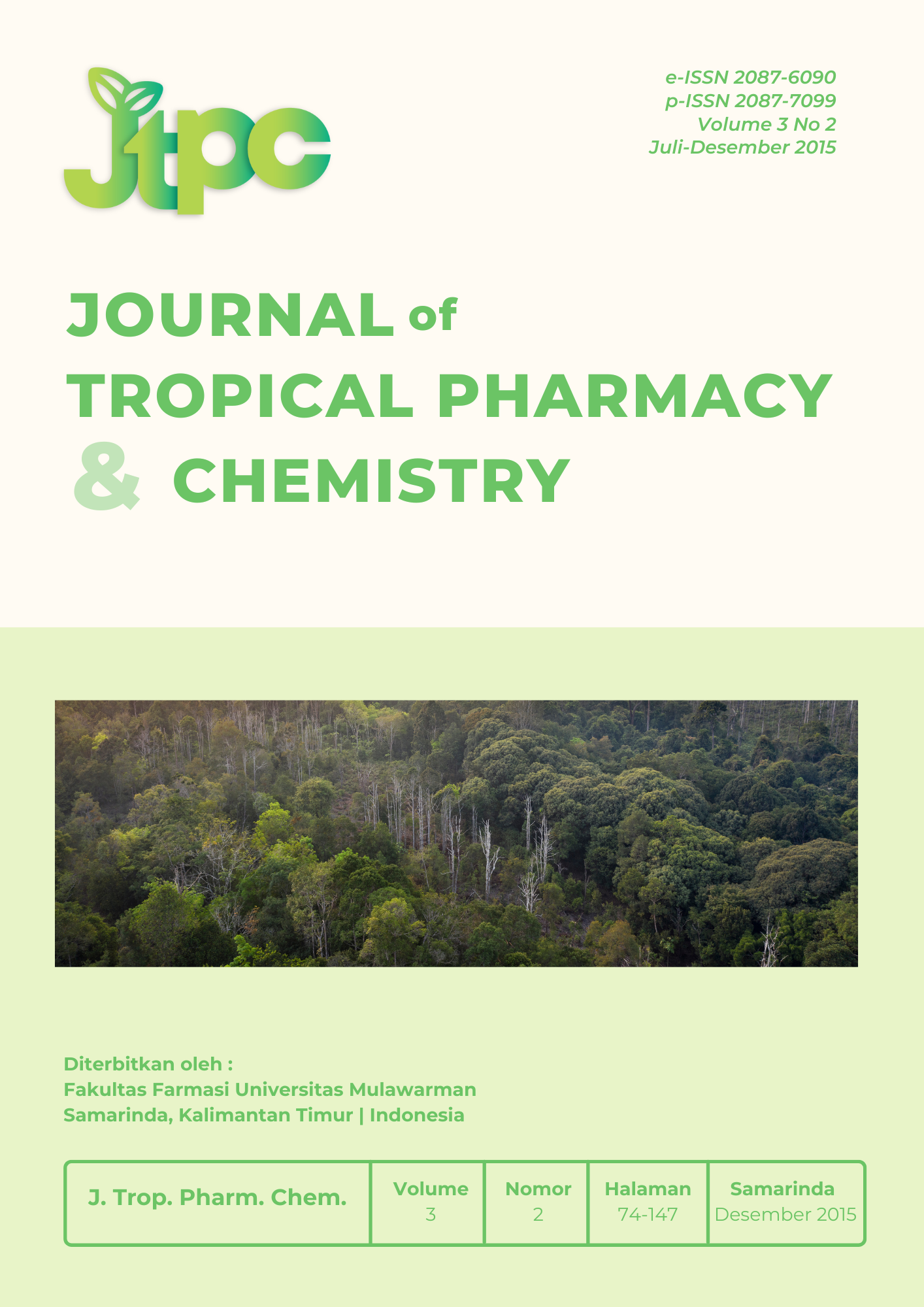Uji Sitotoksik dan Uji Kombinasi Fraksi Etil Asetat Ekstrak Etanol Akar Pasak Bumi (Eurycoma longifolia Jack.,) dan Doksorubisin pada Sel Limfosit
Keywords:
Pasak bumi roots, doxorubicin, Cytotoxicity test, combination test, lymphocyte cellsAbstract
The cytotoxicity and combination test of ethyl acetate fraction of ethanolic extract of Pasak bumi roots (Eurycoma longifolia Jack.) and doxorubicin have been made to the normal lymphocyte cells in vitro. The tests were carried out by using MTT method. Principle of the MTT method is to measure the mitochondrial dehydrogenase activity in living cells that have the ability to convert MTT into formazan. Cytotoxicity test for fraction performed at concentrations of 2000;1000;500;250;125;62,5;31,25 μg/mL and the concentrations of doxorubicin at 4;2;1;0,5;0,25;0,125;0,0625 μg/mL. From the tests IC50 values obtained ethyl acetate fraction of ethanolic extract of pasak bumi roots and doxorubicin against lymphocyte cells each 44 μg/mL and 1.1 μg/mL. The results of combination index (CI) value is 73,282 (CI>1= antagonist) at concentration of the combination 22 μg/mL for ethyl acetate fraction and 0,5547 for doxorubicin. The Results showed ethyl acetate fraction of ethanolic extract of the pasak bumi roots has lower toxicity than doxorubicin and it can be used for the combination chemotherapy with doxorubicin.
Downloads
References
1.Frias, M. A., Lang, U., Gerber-Wicht, C., and James, R. W., 2009, Native
and Reconstituted HDL Protect Cardiomyocytes from Doxorubicin-Induced Apoptosis, Cardiovascular Research, 25(6):36-42.
2.Injac, R., M. Perse., N. Obermajer., V. D. Milic., M. Prijatelj., A. Djordjevic., A. Cerar., B. Strukelj., 2008, Potential hepatoprotective effects of fullerenol C60 (OH) 24 in doxorubicin-induced hepatotoxicity in rats with mammary Carcinomas,
Biomaterials 29(24-25): 3451-3460.
3.Patel, D., and Shukla, 2007. Apigenin and Cancer Chemoprevention: Progress, Potensial, Promise (Review). Internasional Journal Oncology. 30: 233-45
4.Zhang XY, Li WG, Wu YJ. 2005. Amelioration of doxorubicin-induced myocardial oxidative stress and immunosuppression by grape seed proanthocyanidins in tumour-bearing mice. Journal Pharmacy Pharmacology , 57,1043-52.
5.Bhinge, K., and Gupta, V., 2012, The Opposite Effects of Doxorubicin on Bone Marrow Stem Cells Versus Breast Cancer Stem, International Journal Biochemistry Celluler Biology,44(11): 1770-8.
6.Minotti, G., Menna, P., Salvatorelli, E., Cairo,G., andGianni, L. 2004. Anthracyclins: Molecular Advances and Pharmacologic Developments in Antitumor Activity and Cardiotoxicity. Pharmacology Review., 56:185-228.
7.Gewirtz, D.A., 1999, A critical evaluation of the mechanisms of action proposed for the antitumor effects of the anthracycline antibiotics adriamycin and daunorubicin, Biochemistry Pharmacology.,57:727-741.
8.Bruton, L., Lazo, J. S., andParker, K. L., 2005, Goodman & Gilman’s The
Pharmacological Basis of Therapeutics, 11th Edition, McGrawHill, Lange
9.Susilowati, A., 2013, Efek Ekstrak Etanol Akar Paaak Bumi (Eurycoma longifolia Jack) Terhadap Ekspresi Protein CD4 pada Organ Hati Tikus Sprague Dawley yang Diberikan Doxorubicin, Skripsi, Universitas AhmadDahlan, Yogyakarta.
10.Beddir, E., Abou-Gazar, H., Ngwendson, J.N., and Khan I.A., 2003, Eurycomanoside: A new quassinoid from the roots of Eurycoma longifoliaJack, Chem. Pharm. Bull. 51(11): 1301-1303
11.Chan, K., L., Choo, C., Y., Abdullah, N., R., andIsmail, Z., 2005, Semisynthetic 15-O-acyl-and 1,15-di-O-acyleurycomanones fromEurycoma longifolia as potential antimalarials, Plan Med, 71 (10): 967-9
12.Nurhanan, M.Y, Hawairiah, A., Ilham, M.A., and Shukri, M., 2005, Cytotoxic effects of the root extracts of Eurycoma longifolaiaJack, Phytother Res, 19: 994-
996.
13.Tan, H.T., and Raharja, K, 2002, Obat-Obat Penting, Khasiat, Penggunaan, dan Efek-Efek sampingnya, PT. Alex Media Komputindo Kelompok Gramedia, Jakarta, Hal 810.
14.Choo, C.Y. and Chan, K.L. 2002. The Toxicity of some quassinoids from Eurycoma longifolia, Planta Medica, 68: 662-664.
15.Ang, H. H., Y. Hitotsuyanagi, et al. (2002). Quassinoids from Eurycoma longifolia. Phytochemistry59(8): 833-837.
16.Sangat, H.M., Zuhud, E.A.M. dan Damayanti,E.K. 2000. Kamus Penyakit dan Tumbuhan Obat Indonesia. Jakarta: Yayasan Obor Indonesia
17.Nurani, L. H., 2011, Mekanisme Molekuler Kemopreventif dan Antikanker Senyawa Aktif Akar Pasak Bumi (Eurycoma longifoliaJack) Kajian In Vitro pada sel T47D dan In Vivo pada Kanker Payudara pada Tikus SD yang diinduksi DMBA, Disertasi Universitas Gadjah Mada, Yogyakarta
18.Tee, T. T. and H. L. P. Azimahtol (2005). Induction of apoptosis by Eurycoma longifolia Jack extracts. Anticancer research25(3B): 2205-2213
19.Doyle, A., dan Griffiths, J. B. 2000. Cell and Tissue Culture for Medical Research. John Willey and Sons Ltd. : New York
20.Depamede, S.N., 2006. Isolation and characterisation of the immunosuppressive peptides in the rats testis. Thesis. University of Adelaide.
21.Hay, F.C. & Westwood, O.M.R., 2002, Practical Immunology Fourth edition, Blackwell Science, Oxford
22.Meiyanti, 2009, Prosedur Tetap Pengamatan Ekspresi Protein dengan
Metode Imunohistokimia, CCRC, 03-012-01
23.Agustini , N. W. S. 2012. Aktivitas Antioksidan Dan Uji Toksisitas Hayati Pigmen Fikobiliprotein Dari Ekstrak Spirulina Platensis. Seminar Nasional IX pendidikan biologi FKIP UNS. Surakata, Indonesia
24.Srisawat, T., Chumkaew, P., Heed-Chim, W., Sukpondma, Y., and Kanokwiroon, K., Phytochemical screening and cytotoxicity of crude extracts of Vatica diospyroides symington type LS, Tropical Journal of Pharmaceutical Research, vol. 12, no. 1, pp. 71–76, 2013.
25.Melannisa, R., 2004, Pengaruh PGV-1 Pada Sel Kanker Payudara Yang
Diinduksi 17β-Estradiol: Kajian Antiproliferasi, Pemacuan Apoptosis dan Antiangiogenesis, Tesis, Sekolah Pascasarjana, UGM, Yogyakarta
26.Turalely, R., Hadanu, R., Mahulete, F., 2012, Uji Aktivitas Sitotoksik Dan Analisis Fitokimia Ekstrak Daun Kapur (Harmsiopanax aculeatusHamrs), Prosiding Insinas, 1059
27.Chou, T.C., 2010. Drug Combination Studies and Their Synergy Quantification Using the Chou-Talalay Method. American Association for Cancer Research. 443




